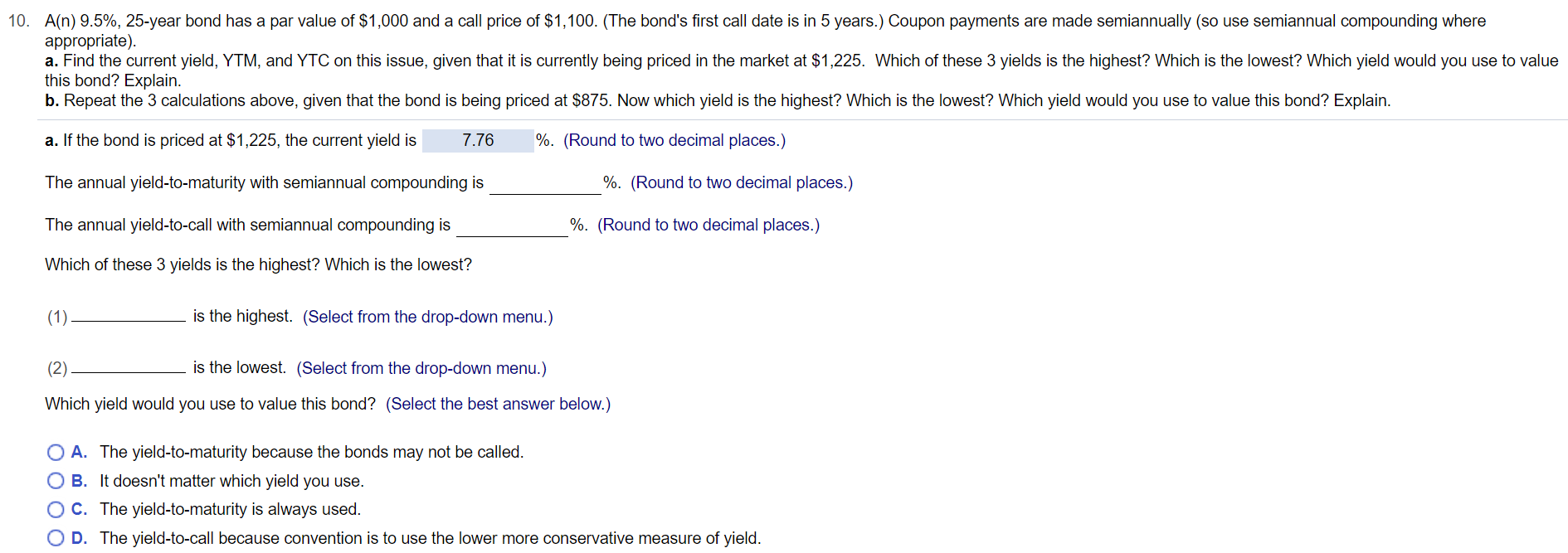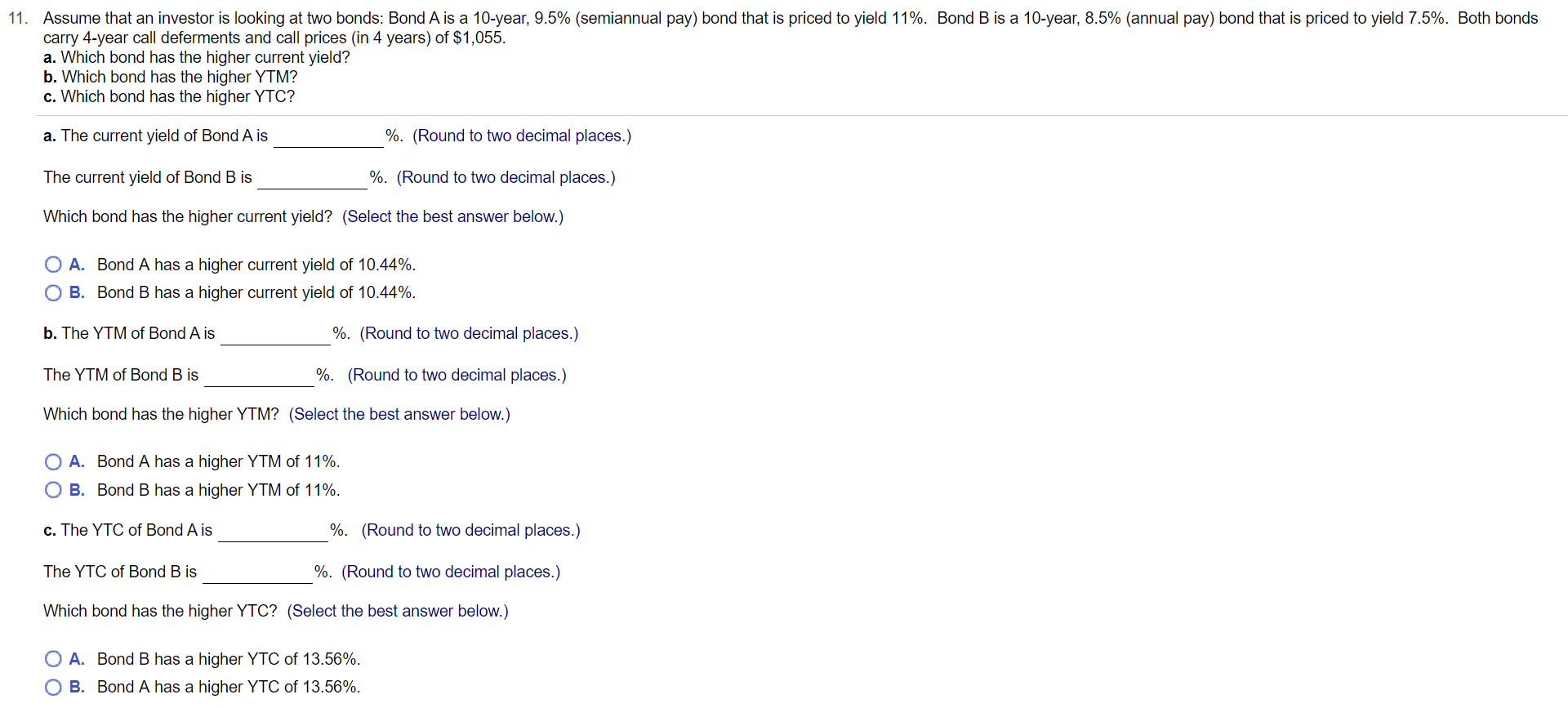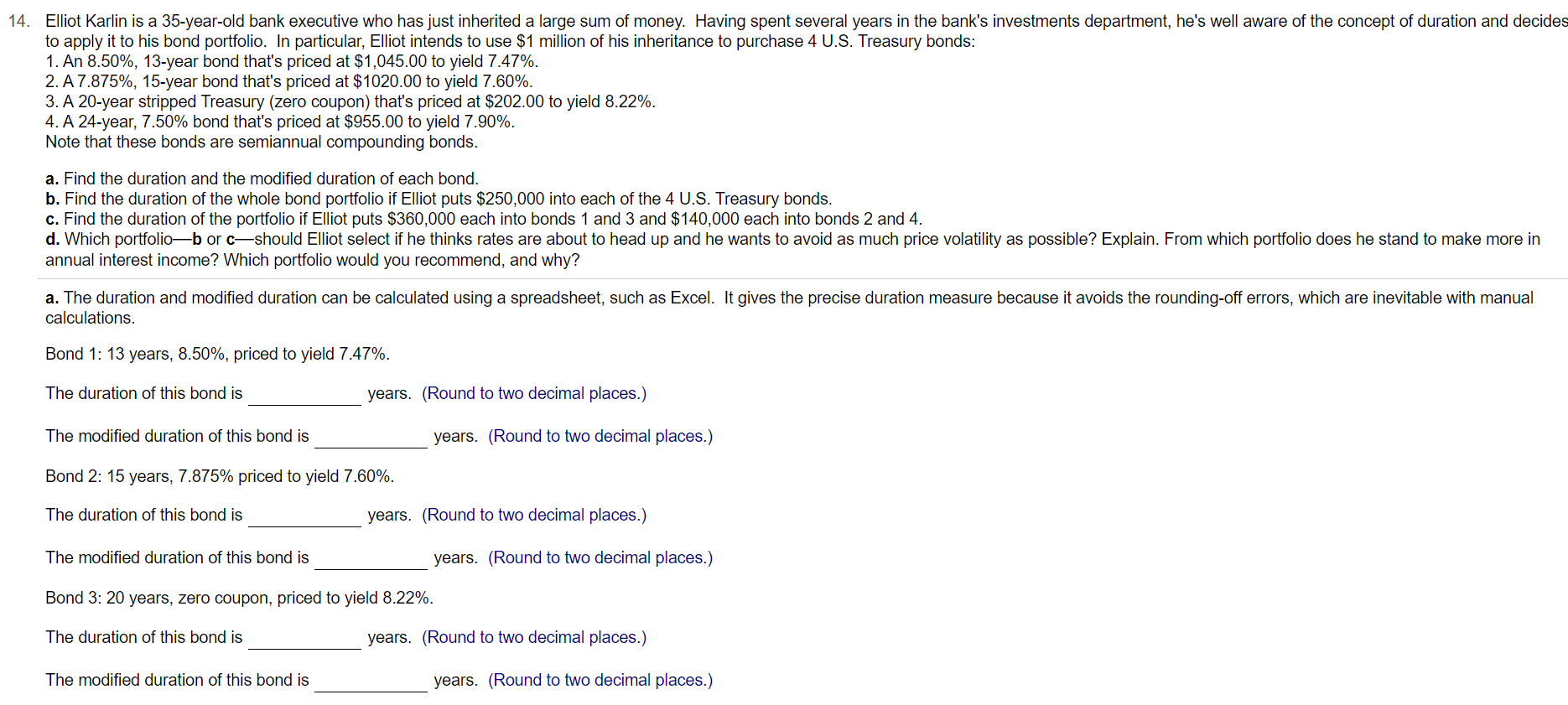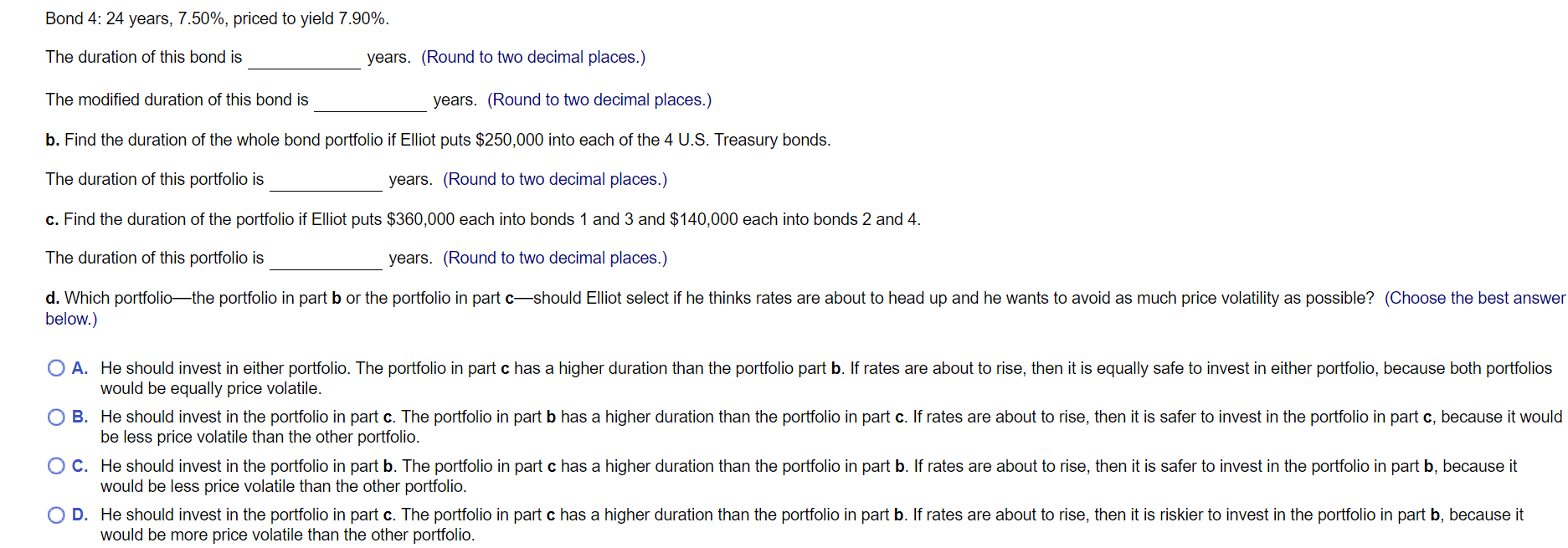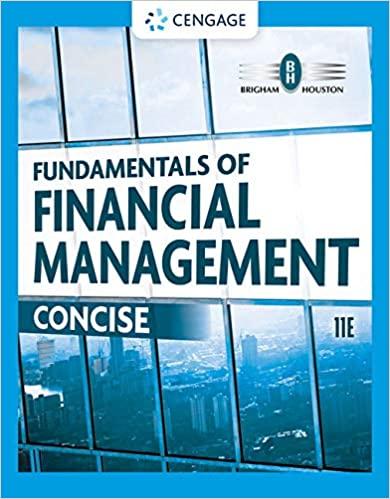

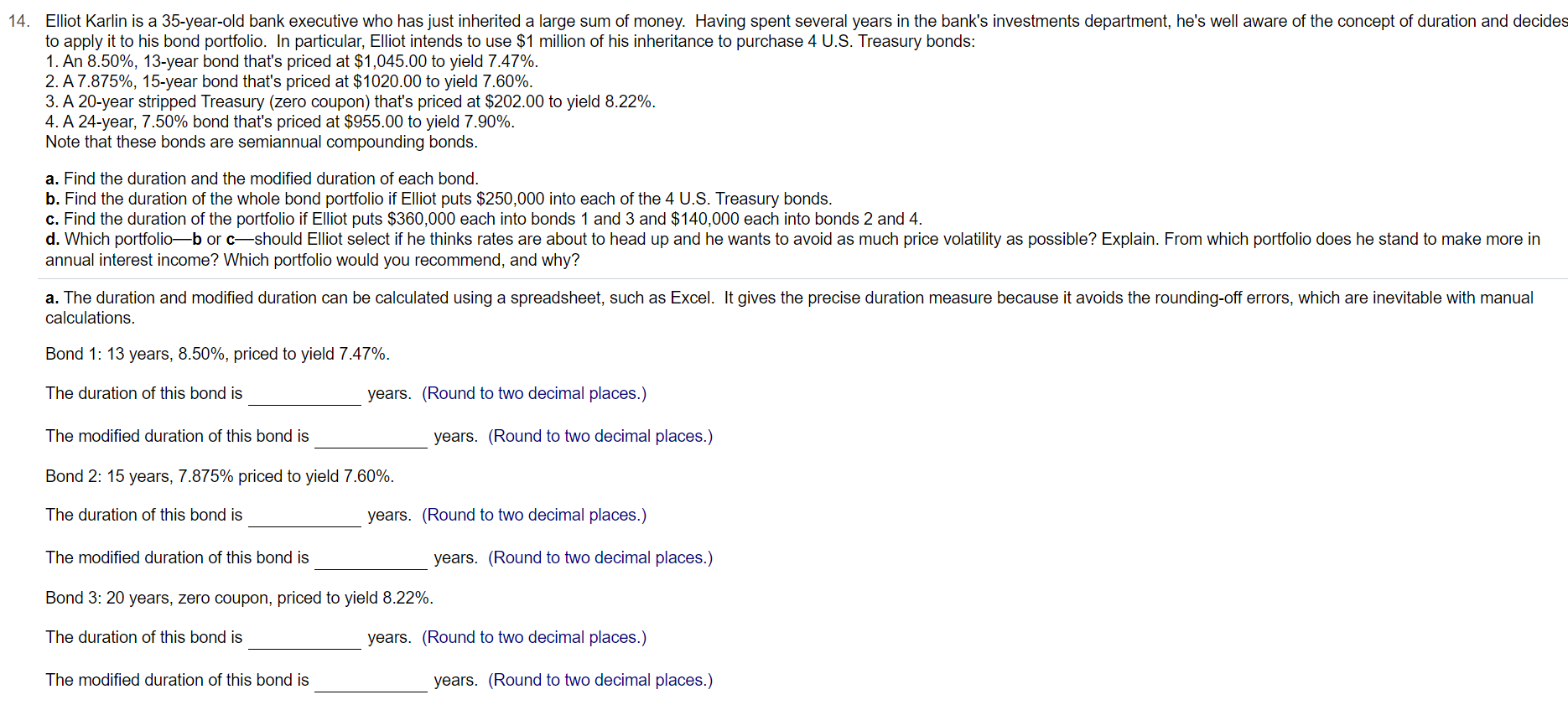
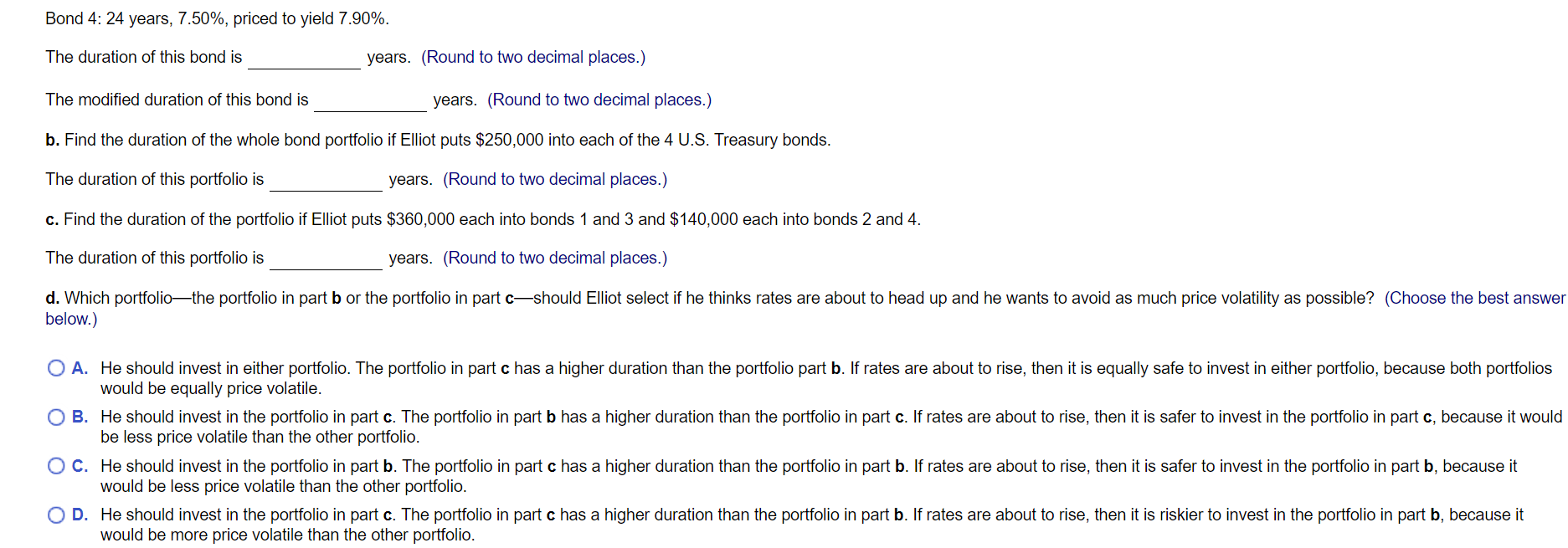
Please help me to solve the following question.
Question 1
10. A(n) 9.5%, 25-year bond has a par value of $1 ,000 and a call price of $1,100. (The bond's rst call date is in 5 years.) Coupon payments are made semiannually (so use semiannual compounding where appropriate). a. Find the current yield, YTM, and YTC on this issue, given that it is currently being priced in the market at $1,225. Which of these 3 yields is the highest? Which is the lowest? Which yield would you use to value this bond? Explain. b. Repeat the 3 calculations above, given that the bond is being priced at $875. Now which yield is the highest? Which is the lowest? Which yield would you use to value this bond? Explain. a. If the bond is priced at $1,225, the current yield is 7.76 %. (Round to two decimal places.) The annual yield-tomaturity with semiannual compounding is ". (Round to two decimal places.) The annual yield-to-call with semiannual compounding is \"fa. (Round to two decimal places.) Which of these 3 yields is the highest? Which is the lowest? (1) is the highest. (Select from the drop-down menu.) (2) is the lowest. (Select from the drop-down menu.) Which yield would you use to value this bond? (Select the best answer below.) 0 A. The yieldtomaturity because the bonds may not be called. 0 B. It doesn't matter which yield you use. O C. The yieldtomaturity is always used. 0 D. The yieldtocall because convention is to use the lower more conservative measure of yield. b. If the bond is priced at $875, the current yield is %. (Round to two decimal places.) The annual yield-to-maturity with semiannual compounding is %. (Round to two decimal places.) The annual yield-to-call with semiannual compounding is %. (Round to two decimal places.) Which of these 3 yields is the highest? Which is the lowest? (3) is the highest. (Select from the drop-down menu.) (4) is the lowest. (Select from the drop-down menu.) Which yield would you use to value this bond? (Select the best answer below.) O A. The yield-to-maturity is always used. O B. It doesn't matter which yield you use. O C. The yield-to-maturity because the bonds may not be called. O D. The yield-to-maturity because convention is to use the lower of yield-to-maturity or yield-to-call for bonds selling at a discount. (1) O Yield-to-maturity (2) O Yield-to-maturity (3) O Current yield (4) O Yield-to-call O Yield-to-call O Current yield O Yield-to-maturity O Current yield O Current yield O Yield-to-call O Yield-to-call O Yield-to-maturity11. Assume that an investor is looking at two bonds: Bond A is a 10-year, 9.5% (semiannual pay) bond that is priced to yield 11%. Bond B is a 10-year, 8.5% (annual pay) bond that is priced to yield 7.5%. Both bonds carry 4-year call deferments and call prices (in 4 years) of $1 ,055. 3. Which bond has the higher current yield? b. Which bond has the higher YTM? c. Which bond has the higher YTC? a. The current yield of Band A is ". (Round to two decimal places.) The current yield of Bond B is %. (Round to two decimal places.) Which bond has the higher current yield? (Select the best answer below.) 0 A. Bond A has a higher current yield of 10.44%. 0 B. Bond B has a higher current yield of 10.44%. b. The YTM of Bond A is %. (Round to two decimal places.) The YTM of Bond B is %. (Round to two decimal places.) Which bond has the higher YTM? (Select the best answer below.) 0 A. Bond A has a higher YTM of 11%. O B. Bond B has a higher YTM of 11%. c. The YTC of Bond A is ". (Round to two decimal places.) The YTC of Bond Bis %. (Round to two decimal places.) Which bond has the higher YTC? (Select the best answer below.) 0 A. Bond B has a higher YTC of 13.56%. 0 B. Bond A has a higher YTC of 13.56%. 12. Find the Macaulay duration and the modied duration of a 15-year, 7.5% corporate bond priced to yield 5.5%. According to the modied duration of this bond, how much of a price change would this bond incur if market yields rose to 5.5%? Using annual compounding, calculate the price of this bond in one year if rates do rise to 6.5%. How does this price change compare to that predicted by the modied duration? Explain the difference. The Macaulay duration is years. (Round to two decimal places.) The modied duration is years. (Round to two decimal places.) If market yields rose to 6.5%, the change would be %. (Round to two decimal places.) Using annual compounding, the price of this bond in 1 year if rates do rise to 5.5% is $ . (Round to the nearest cent.) The actual percentage change in bond price is ". (Round to two decimal places.) Which of the following is true? (Select the best choice below.) 0 A. Duration is not a good predictor of price volatility if interest rates undergo a big swing because of the convex relationship of a bond's price-yield relationship. 0 B. Duration is a good predictor of price volatility if rates change less than 2%. O C. Duration is a good predictor of price volality because of the convex relationship of a bond's price-yield relationship. 0 D. Duration is not a good predictor of price volatility it rates change more than a basis point. 13. Which one of the following bonds would you select if you thought market interest rates were going to fall by 50 basis points over the next six months? a. A bond with a Macaulay duration of 8.46 years that's currently being priced to yield 7.50%. b. A bond with a Macaulay duration of 9.30 years that's priced to yield 10.00%. c. A bond with a Macaulay duration of 8.75 years that's priced to yield 5.75%. a. The modied duration for a bond with a Macaulay duration of 3.46 years that's currently being priced to yield 7.50% is years. (Round to two decimal places.) b. The modied duration for a bond with a Macaulay duration of 9.30 years that's priced to yield 10.00% is years. (Round to two decimal places.) c. The modied duration for a bond with a Macaulay duration of 8.75 years that's priced to yield 5.75% is years. (Round to two decimal places.) Which is the best selection? (Select the best answer below.) 0 A. When market rates fall, the value (price) of a bond rises. For a given change in interest rates, the bond with the highest modied duration will offer maximum price appreciation potential and therefore should be selected. Bond (b) otters the potential for maximum capital appreciation. To maximize gains, this bond should be selected over the others. 0 B. When market rates fall, the value (price) of a bond falls. For a given change in interest rates, the bond with the highest modied duration will offer maximum price appreciation potential and therefore should be selected. Bond (a) offers the potential for maximum capital appreciation. To maximize gains, this bond should be selected over the others. 14. Elliot Karlin is a 35-year-old bank executive who has just inherited a large sum of money. Having spent several years in the bank's investments department, he's well aware of the concept of duration and decides to apply it to his bond portfolio. In particular, Elliot intends to use $1 million of his inheritance to purchase 4 U.S. Treasury bonds: 1.An 8.50%, 13year bond that's priced at $1,045.00 to yield 7.47%. 2. A 7.875%, 15-year bond that's priced at $1020.00 to yield 7.60%. 3. A 20-year stripped Treasury (zero ooupon) that's priced at $202.00 to yield 8.22%. 4. A 24-year, 7.50% bond that's priced at $955.00 to yield 7.90%. Note that these bonds are semiannual compounding bonds. 3. Find the duration and the modied duration of each bond. b. Find the duration of the whole bond portfolio if Elliot puts $250,000 into each of the 4 U.S. Treasury bonds. :2. Find the duration of the portfolio if Elliot puts $360,000 each into bonds 1 and 3 and $140,000 each into bonds 2 and 4. d. Which portfoliob or cshould Elliot select if he thinks rates are about to head up and he wants to avoid as much price volatility as possible? Explain. From which portfolio does he stand to make more in annual interest income? Which porttolio would you recommend, and why? a. The duration and modied duration can be calculated using a spreadsheet, such as Excel. It gives the precise duration measure because it avoids the rounding-off errors, which are inevitable with manual calculations. Bond 1: 13 years, 8.50%, priced to yield 7.47%. The duration of this bond is years. (Round to two decimal places.) The modied duration of this bond is years. (Round to two decimal places.) Bond 2: 15 years, 7.875% priced to yield 7.60%. The duration of this bond is years. (Round to two decimal places.) The modied duration of this bond is years. (Round to two decimal places.) Bond 3:20 years, zero coupon, priced to yield 8.22%. The duration of this bond is years. (Round to two decimal places.) The modied duration of this bond is years. (Round to two decimal places.) Bond 4 :24 years, 7.50%, priced to yield 7.90%. The duration of this bond is years. (Round to two decimal places.) The modied duration of this bond is years. (Round to two decimal places.) b. Find the duration of the whole bond portfolio if Elliot puts $250,000 into each of the 4 U.S. Treasury bonds. The duration of this portfolio is years. (Round to two decimal places.) c. Find the duration of the portfolio if Elliot puts $360,000 each into bonds 1 and 3 and $140,000 each into bonds 2 and 4. The duration of this portfolio is years. (Round to two decimal places.) (I. Which portfoliothe portfolio in part b or the porfolio in part cshould Elliot select if he thinks rates are about to head up and he wants to avoid as much price volatility as possible? (Choose the best answer below.) 0 A. o B. o c. o D. He should invest in either portfolio. The port'olio in part c has a higher duration than the portfolio part b. If rates are about to rise, then it is equally safe to invest in either portfolio, because both portfolios would be equally price volatile. He should invest in the por olio in part c. The portfolio in part b has a higher duration than the portfolio in part c. If rates are about to rise, then it is safer to invest in the portfolio in part 1:, because it would be less price volatile than the other portfolio. He should invest in the por olio in part b. The portfolio in part c has a higher duration than the portfolio in part b. If rates are about to rise, then it is safer to invest in the portfolio in part b, because it would be less price volatile than the other portfolio. He should invest in the portfolio in part c. The portfolio in part c has a higher duration than the portfolio in part b. If rates are about to rise, then it is riskier to invest in the portfolio in part b, because it would be more price volatile than the other portfolio




